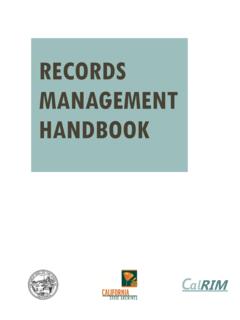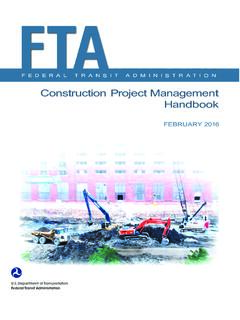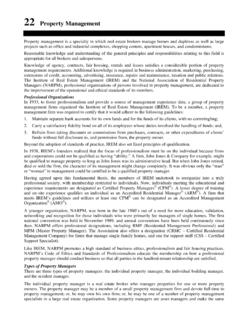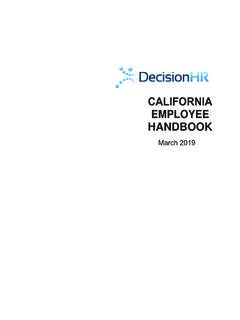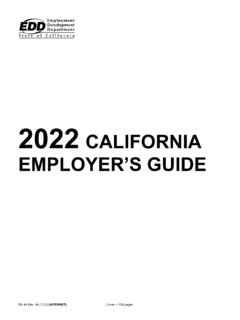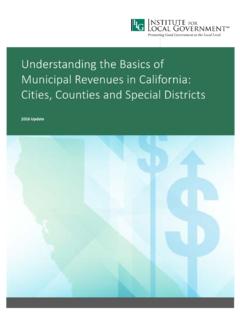Transcription of RECORDS MANAGEMENT HANDBOOK - California
1 RECORDS . MANAGEMENT . HANDBOOK . RECORDS Retention RECORDS Retention HANDBOOK Introduction / RMC. STATE OF California . RECORDS MANAGEMENT HANDBOOK . RECORDS RETENTION. The RECORDS MANAGEMENT Program section of the State Administrative Manual (Chapter 1600) defines the responsibility of each agency to implement a RECORDS MANAGEMENT program and prescribes the procedure for scheduling and disposing of RECORDS . This RECORDS Retention HANDBOOK supplements the information in the State Administrative Manual and the procedural publications displayed on the California RECORDS and Information Program's (CalRIM) website calrim/.
2 While the HANDBOOK has been written primarily to assist agency RECORDS MANAGEMENT coordinators, it will also be useful to Legal Staff, file room supervisors and other interested agency personnel. Prepared By: California RECORDS and Information MANAGEMENT Program (CalRIM). California State Archives Office of the Secretary of State July 21, 2014. Abbreviations CalRIM - California RECORDS and Information Program RMC - RECORDS MANAGEMENT Coordinator RRS - RECORDS Retention Schedule SAM - State Administrative Manual SRC - State RECORDS Center SRAP - State RECORDS Appraisal Program Forms Abbreviations STD 70 - RECORDS Inventory Worksheet, STD 70.
3 STD 71 - RECORDS Transfer List, STD 71. STD 73 - RECORDS Retention Schedule, STD 73. STD 76 - State RECORDS Center Reference Request, STD 76. GS-50 - State RECORDS Special Authorization, GS-50. RECORDS Retention HANDBOOK Introduction / RMC. TABLE OF CONTENTS. RECORDS Retention HANDBOOK Page Introduction 1. Establishing the Program 2. Steps in Establishing the Program 3. RECORDS MANAGEMENT Coordinator 4. What are RECORDS 5. Preparing for the Inventory 6. What Information is Required for the Inventory? 6. RECORDS Inventory Worksheet (STD 70) 9. RECORDS Inventory Worksheet (Instructions) 10. RECORDS Appraisal and Scheduling 11.
4 Determining Retention Periods 12. What is a RECORDS Retention Schedule? 13. RECORDS Retention Schedule (STD 73) 14. RECORDS Retention Schedule (Instructions) 16. Creating the Schedule 18. Approval of Retention Schedules 19. Amending Retention Schedules 19. Applying Retention Schedules 20. Keeping Retention Schedules Current 21. State RECORDS Center Services 22. Instructions for Transferring RECORDS to the State RECORDS Center 23. RECORDS Transfer (SList TD 71) 27. RECORDS Transfer List (STD 71, Instructions) 28. Vault Storag foe r Vital RECORDS 29. Instructions for Referring to RECORDS Stored in the State RECORDS Center (SRC) 30.
5 State RECORDS Center Reference Request (STD 76) 30. Emergency Requests 31. Instructions for Reviewing RECORDS at the State RECORDS Center 32. Instructions for Destroying RECORDS Stored at the SRC 33. Instructions for Preparing GS-50, State RECORDS Special Authorization 35. State RECORDS Special Authorization (GS-50, Blank Form) 36. Instructions for Preparing GS 50 (Reverse Side) 37. Instructions for Transferring RECORDS from Offices or Departmental Storage for Disposal 38. Authorization for RECORDS Destruction (Printout) 39. Glossary of Terms 40. RECORDS MANAGEMENT Program Checklist 52. Guidelines for Justifying Purchase of Filing Equipment 53.
6 Checklist for Pre-Purchase Considerations and Reviews for Electronic RECORDS Systems 54. Sanctions for Failing to Locate RECORDS for Pre-Trial Discovery 55. RECORDS Retention HANDBOOK Introduction / RMC. INTRODUCTION. Our ability to control RECORDS has not kept pace with our ability to create them. We have computers that print multiple legible copies, high-speed copiers and duplicating machines that grind out reams of paper, word processors that facilitate the writing process and e-mail systems that produce thousands of communications daily. In today's highly technical environment the majority of our RECORDS are created and maintained electronically.
7 The creation of paper copies is considered counterproductive and discouraged by RECORDS managers but paper holdings continue to increase. This lack of control over the creation, maintenance, retention and disposition of RECORDS manifests itself in a number of ways. Look, for example, at your own agency. Do you know how many RECORDS you have and where they are? Who uses those RECORDS and how often? Do you know how much it costs to store your RECORDS ? Do you know how much time is wasted on the maintenance of inactive RECORDS ? Do you know how much money you have invested in filing equipment? Does your agency have retention schedules that account for all of its RECORDS ?
8 Are the schedules being applied? If you have retention schedules, when did you last review them to see if the retention periods should be changed? WHAT IS RECORDS MANAGEMENT ? California 's RECORDS MANAGEMENT Program is designed to apply efficient and economical MANAGEMENT methods to the creation, utilization, maintenance, retention, preservation and disposal of state RECORDS (Government Code 12272 (a)). The end result of this effort is to ensure that information contained in the state's RECORDS is available when and where it is needed at the least possible cost. This HANDBOOK deals with several elements of a RECORDS MANAGEMENT program: the inventorying and scheduling of RECORDS owned by an agency; the systematic transfer of inactive RECORDS from office to storage; and the regular destruction of RECORDS that no longer have value.
9 Properly managed, RECORDS protect personal and organizational rights, and support, defend, and account for the state's business activities. RECORDS RETENTION SCHEDULES. RECORDS retention schedules are written policies outlining the treatment of state RECORDS regardless of format. They are a plan for the use of a business resource, just as a budget is a plan for the use of money. Properly prepared schedules save physical and electronic storage space by removing from offices RECORDS that no longer have significant value; and by maintaining a regular, controlled flow of RECORDS from physical and electronic storage receptacles to multi-media vital RECORDS storage facilities, state RECORDS center storage, or scheduled destruction.
10 The State of California uses STD 73, RECORDS Retention Schedule to: 1. RECORDS Retention HANDBOOK Introduction / RMC. Save Space by removing from offices RECORDS that are not required for daily operations; by removing from storage areas RECORDS that no longer have significant value; and by maintaining a regular, controlled flow of RECORDS from to storage to destruction. Save money by controlling the purchase of equipment and supplies to file unneeded RECORDS ; by providing inexpensive storage facilities for less active RECORDS ; and by releasing surplus paper filing equipment, micrographic readers/printers/storage containers for re-use or sale.

